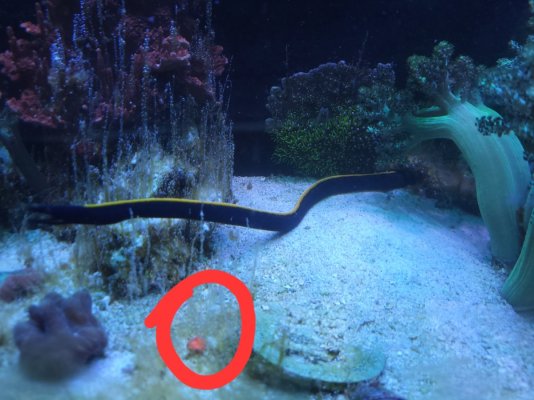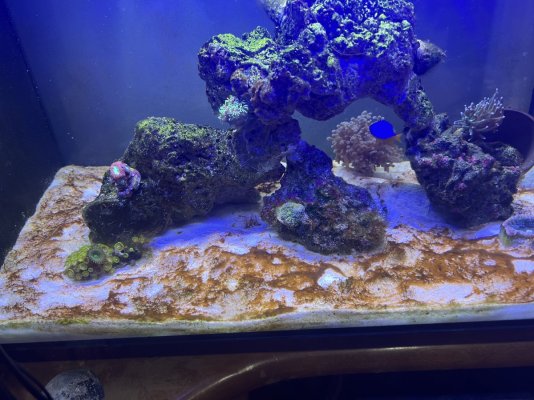Went to my lfs because I wanted to make a refugium in my filter bc I don’t have many copepods (I have a fluval evo 13.5) but the owner told me that if chaeto were to get into the display that oxygen would be depleted in a day and everything would die. Looking for a risk free alternative macro so in case it go’s into my display oxygen won’t deplete. Thank you!
Navigation
Install the app
How to install the app on iOS
Follow along with the video below to see how to install our site as a web app on your home screen.
Note: This feature may not be available in some browsers.
More options
You are using an out of date browser. It may not display this or other websites correctly.
You should upgrade or use an alternative browser.
You should upgrade or use an alternative browser.
Macro that doesn’t deplete oxygen
- Thread starter clownaround4giggles
- Start date
- Tagged users None
Very oddI never heard of chaeto using oxygen... my sumps full of chaetomorpha. Its often in my display as well.
Odd information.
Yeah that's not even remotely true. The product of photosynthesis is oxygen, which nearly all photosynthetic organisms release throughout the day. I assume your LFS guy got confused and mixed up CO2 and O2.
Thats my guess it will also raise ph because it's using co2.Yeah that's not even remotely true. The product of photosynthesis is oxygen, which nearly all photosynthetic organisms release throughout the day. I assume your LFS guy got confused and mixed up CO2 and O2.
Chaeto is photosynthetic macroalgae. They release a large amount of oxygen into the water. Chaeto filters the phosphates and nitrates in the water, when it dies it can release the nutrients it has stored up in the algae and create a spike but it definitely won't take Oxygen out of the water
No, because he said the lfs guy said " everything will die"Yeah that's not even remotely true. The product of photosynthesis is oxygen, which nearly all photosynthetic organisms release throughout the day. I assume your LFS guy got confused and mixed up CO2 and O2.
Id run from that place...
What size tank do you have, mine is pretty smallI never heard of chaeto using oxygen... my sumps full of chaetomorpha. Its often in my display as well.
Odd information.
I also have a plume of dinos in my tank for a while now, would that affect the answer?I never heard of chaeto using oxygen... my sumps full of chaetomorpha. Its often in my display as well.
Odd information.
112gWhat size tank do you have, mine is pretty small
Chaeto doesn't consume oxygen. Dinos will. 2 different life forms that are on polar opposites.I also have a plume of dinos in my tank for a while now, would that affect the answer?
Are these Dino’s btw?112g
Chaeto doesn't consume oxygen. Dinos will. 2 different life forms that are on polar opposites.
Attachments
That can be several things, or a combination. Diatoms and/or cyanoAre these Dino’s btw?
Dinoflagellates will turn all stringy. Like in my photo above.
You can take a turkey baster, blast water at the stuff on your sand.
If it blows away as a sheet, cyano
If it breaks apart like dust, diatoms
But, looks mostly like cyano.
Which types of dinos (in reef tanks) consume oxygen? Many are photosynthetic.Chaeto doesn't consume oxygen. Dinos will. 2 different life forms that are on polar opposites.
My bad, i confused that with cyano's bad behavior.Which types of dinos (in reef tanks) consume oxygen? Many are photosynthetic.
Photosynthetic organisms actually do consume oxygen but not as much as they produce. It's known as oxygenic photosynthesis. They also release sugars which feed bacteria which also consume oxygen.
Theses these types of posts as well. They confuse me, butWhich types of dinos (in reef tanks) consume oxygen? Many are photosynthetic.
They steal/deplete oxygen?The cells of Osteropsis ovata have a diameter at their largest part, about 40 micro meters, which, if we compare it to the diameter of a cyanobacteria cell (2-3 micro meters), gives us an idea of its relative size. Ostreopsis, like many other harmful dinoflagellates, secretes a large amount of mucus to build extracellular matrices, macroscopically characterized by the presence of strands and filaments, in which oxygen bubbles resulting from photosynthesis are trapped. These matrices settle on any existing substrate, sand, rocks, glasses, etc., suffocating the existing micro fauna.This can be observed, for example, when the aggregates formed on the substratum are siphoned off, revealing areas of sand with a dark gray color, indicating anaerobic bacterial activity, resulting from the depletion of oxygen produced by the layer of dinoflagellates settled on top. The extracellular matrices also serve to immobilize potential predators such as amphipods and copepods.
This LFS and that guy have no idea what they are talking about. I’d find a new store if I were youWent to my lfs because I wanted to make a refugium in my filter bc I don’t have many copepods (I have a fluval evo 13.5) but the owner told me that if chaeto were to get into the display that oxygen would be depleted in a day and everything would die. Looking for a risk free alternative macro so in case it go’s into my display oxygen won’t deplete. Thank you!
Most aquatic plants and macro algae's produce O2 during photosynthesis and consume CO2. At night they stop photosynthesis and consume O2. Typically they produce more O2 then they consume though. There are other factors at work here also like @Garf said. In either case I dont see them killing everything in the tank in a normal situation. Some types of macro can "go sexual" this can cause issues with O2 levels maybe this is what the lfs was worried or talking about? I have kept lots of macro algae's and haven't had this happen yet.
Similar threads
- Replies
- 2
- Views
- 214
- Replies
- 6
- Views
- 297
- Replies
- 4
- Views
- 340
- Replies
- 1
- Views
- 318





















